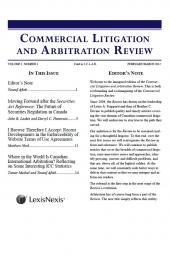Business and Human Rights as Law: Towards Justiciability of Rights, Involvement, and Remedy
One Year Subscription Only Terms
Subscribers receive the product(s) listed on the Order Form and any Updates made available during the annual subscription period. Shipping and handling fees are not included in the annual price.
Subscribers are advised of the number of Updates that were made to the particular publication the prior year. The number of Updates may vary due to developments in the law and other publishing issues, but subscribers may use this as a rough estimate of future shipments. Subscribers may call Customer Support at 800-833-9844 for additional information.
Subscribers may cancel this subscription by: calling Customer Support at 800-833-9844; emailing customer.support@lexisnexis.com; or returning the invoice marked 'CANCEL'.
If subscribers cancel within 30 days after the product is ordered or received and return the product at their expense, then they will receive a full credit of the price for the annual subscription.
If subscribers cancel between 31 and 60 days after the invoice date and return the product at their expense, then they will receive a 5/6th credit of the price for the annual subscription. No credit will be given for cancellations more than 60 days after the invoice date. To receive any credit, subscriber must return all product(s) shipped during the year at their expense within the applicable cancellation period listed above.
Product description
Cited by the Supreme Court of Canada in the Nevsun Resources Ltd. v. Araya case
As the authors explain in the Introduction to this book, the United Nations Guiding Principles on Business and Human Rights are transforming corporate responsibility from public relations art to legal science. While the Guiding Principles are soft law, their definition of business respect for human rights has inspired a paradigm shift in human rights-related corporate legal risk through a wave of national legislation and transnational litigation. The contours of the emerging legal risk, however, are vague.
Business and Human Rights as Law: Towards Justiciability of Rights, Involvement, and Remedy is the first text to subject the Guiding Principles’ foundational concepts to legal analysis in search of precise, practical, and replicable guidance. The result is a unique blend of theory and practice—illustrated through complex, real-world examples—to help lawyers and judges unearth the objective bases of corporate human rights responsibility and liability.
Features:
- An overview of the Guiding Principles’ practical, governance-based expectations of business respect for human rights, highlighting the similarities with corruption compliance programs.
- A global survey of trends in litigation, legislation, and international law related to corporate human rights governance and risk management.
- Rights: An analysis of how international human rights law, conceived to bind public actors, can reasonably and practically be translated into a purely private context, drawing on equity and abuse of right.
- Involvement: A multidisciplinary investigation of the practical meaning of cause, contribute, directly linked, and omission to provide principled certainty regarding which adverse human rights impacts businesses are expected to foresee, identify, and address.
- Grievance mechanisms: An exploration of how to evaluate the effectiveness of a private remedial process, drawing on extracts from an assessment of an extremely complex and controversial operational-level grievance mechanism established by Barrick Gold in Papua New Guinea.
- Remedy: An analysis of how to ensure remedial outcomes are rights-compatible by translating the right to remedy from a public to private context, with reference to legitimate corporate ends and constraints.
A novel and practical treatise
This book would be a useful resource for:
- Corporate disputes and transaction counsel who advise leading businesses on navigating global human rights liability and governance expectations.
- Judges and arbitrators who need to hear and resolve transnational, human rights-related civil claims
- Academics who seek to understand and explore the quickly evolving legal discipline of business and human rights.
- In-house counsel who advise on designing human rights and sustainability governance policies and procedures to navigate legal, financial, and reputational risk.
Table of contents
Chapter 1: Introduction: Towards justiciability
A. The evolution of corporate responsibility
B. The justiciability challenge
C. Overview of this book
D. Our interpretive approach
Chapter 2: Legal risk
A. Introduction: Business and human rights as a legal science
B. Litigation: Adjudicating responsibility for human rights
C. Legislation: The grand experiment
D. International treaty
E. Towards a justiciable standard of care for business and human rights
Chapter 3: Rights
A. Introduction
B. The structure of rights
C. The structure of human rights
D. A typology of human rights
E. The Guiding Principles and the two dimensions of rights
F. Conclusion
Chapter 4: Involvement
A. Introduction
B. Fact pattern: Modern slavery and the financial sector
C. Cause or contribute
D. Omission
E. Directly linked
F. Conclusion
G. Case studies: Cause and contribute
H. Case studies: Directly linked
Chapter 5: Grievance mechanisms
A. Introduction
B. Case study: Overview of the Framework
C. Assessment of the Framework
D. Lessons from the Framework
Appendix: Indicators for an adjudicative operational-level grievance mechanism
Chapter 6: Rights-compatible remedy
A. Introduction
B. Effective remedy in international law
C. Conclusion
Postscript: A word of caution and a call to arms
 Lexis Nexis
Lexis Nexis 


